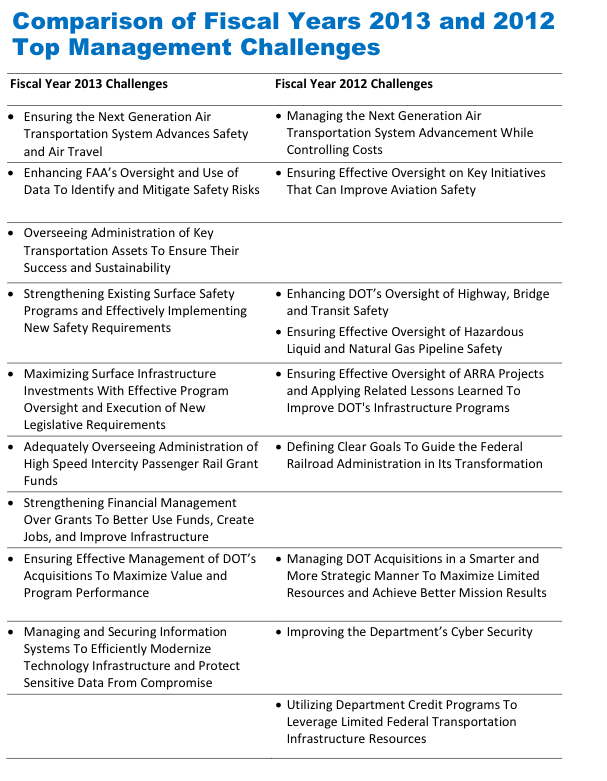US DEPARTMENT OF TRANSPORTATION
Chapter 1: Ensuring the Next Generation Air Transportation System Advances Safety and Air Travel
The National Airspace System (NAS) handles almost 50,000 flights per day and more than 700 million passengers per year. Air travel is expected to nearly double over the next 2 decades, and the Federal Aviation Administration (FAA) has been working for 8 years to develop the Next Generation Air Transportation System (NextGen). NextGen is intended to modernize aging equipment, systems, and facilities and improve airspace efficiency. While FAA has made some progress toward improved air traffic management, our work continues to find longstanding problems with cost increases, schedule slips, and performance shortfalls with key FAA modernization projects—challenges that have been exacerbated by the fiscally constrained Federal environment.
Key Challenges
- Realizing benefits from NextGen capabilities at congested airports in the near term
- Mitigating risks that delays with the En Route Automation Modernization program pose to critical NextGen initiatives
- Making decisions on facility consolidation and modernization • Completing an integrated master schedule for NextGen transformational programs
- Achieving expected outcomes from reorganization to improve NextGen management
- Integrating Unmanned Aircraft Systems in the National Airspace System
Realizing Benefits From NextGen Capabilities at Congested Airports in the Near Term
In response to recommendations by a Government-industry task force in 2009, FAA launched its “metroplex” initiative—a 7-year effort to improve the flow of traffic and efficiency at congested airports in 13 major metropolitan areas. FAA completed initial studies to identify and recommend airspace and procedure improvements at 7 of the 13 metroplex locations and is performing design work at 6. However, FAA continues to face challenges with shifting from planning to implementation. The expected completion date for all metroplex sites is now 15 months later than FAA planned. Further, industry representatives are concerned that the effort may not deliver all desired benefits since FAA has focused on limited airspace and procedure improvements rather than maximizing new technologies and advanced procedures, as recommended by the task force. According to FAA officials, the Agency has taken this approach to avoid potentially extensive environmental reviews and accommodate all airspace users, not just those equipped to fly advanced procedures. However, nearly half of all active commercial aircraft are currently equipped to fly advanced procedures, and representatives from air carriers who are equipped stated that FAA’s approach offers little operational and financial benefits to airlines. In addition, FAA has not yet integrated efforts from other related initiatives, such as better managing airport surface operations, into the metroplex initiative. As a result, airspace users are concerned about the pace and execution of the metroplex effort, as well as the lack of clearly defined expected benefits, and remain reluctant to equip with new avionics.
FAA also has not yet resolved various barriers to its metroplex effort—which have slowed other NextGen initiatives. These include working across diverse Agency lines of business, updating policies, streamlining the process for implementing new flight procedures, applying environmental regulations, upgrading controller automation tools, and training controllers on new advanced procedures. FAA is working to address our August 2012 recommendations to effectively implement the task force’s recommendations and resolve these barriers in a timely manner.
Mitigating Risks That Delays With the En Route Automation Modernization Program Pose to Critical NextGen Initiatives
Increasing airspace capacity and reducing flight delays depend on the successful implementation of the En Route Automation Modernization program (ERAM)—a $2.1 billion system to replace hardware and software at FAA’s facilities that manage high-altitude traffic. FAA originally planned to complete ERAM by the end of 2010. However, software problems have impacted the system’s ability to safely manage and separate aircraft and raised questions as to what capabilities ERAM will ultimately deliver. FAA rebaselined the program in 2011, which pushed its expected completion to 2014 and increased cost estimates by $330 million. FAA is taking steps to get ERAM on track and is using the system on a full-time basis at several sites—a significant step forward given the extensive software problems during testing at the two initial sites. Recent progress at those two sites has allowed FAA to phase out their legacy air traffic control systems. However, other facilities continue to identify software problems, and FAA will likely encounter these and other issues when it implements ERAM at some of the Nation’s busiest facilities. If software problems persist, the program’s cost growth could exceed $500 million, and delays could stretch out to 2016. Prolonged delays with ERAM will directly impact the overall cost and pace of NextGen. Without ERAM, the benefits of several other programs, such as a new satellite-based surveillance system and data communications for controllers and pilots, will not be possible.
Read full report (PDF) here: Top Management Challenges For Fiscal Year 2013
About the USDOT
www.dot.gov
“The mission of the Department is to: Serve the United States by ensuring a fast, safe, efficient, accessible and convenient transportation system that meets our vital national interests and enhances the quality of life of the American people, today and into the future.”
Tags: Top Management Challenges For Fiscal Year 2013, U.S. Department of Transportation, USDOT







 RSS Feed
RSS Feed